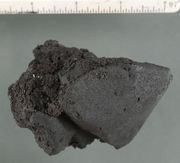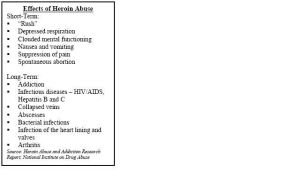It07:Heroin
Heroin
Heroin is an illegal, highly addictive drug. It is both the most abused and the most rapidly acting of the opiates. Heroin is processed from morphine, a naturally occurring substance extracted from the seed pod of certain varieties of poppy plants. It is typically sold as a white or brownish powder or as the black sticky substance known on the streets as "black tar heroin." Although purer heroin is becoming more common, most street heroin is "cut" with other drugs or with substances such as sugar, starch, powdered milk, or quinine. Street heroin also can be cut with strychnine or other poisons. Because heroin abusers do not know the actual strength of the drug or its true contents, they are at risk of overdose or death. Heroin also poses special problems because of the transmission of HIV and other diseases that can occur from sharing needles or other injection equipment.

| It07:Heroin | |
|---|---|

| |
| 3D structure | XML error: Mismatched tag at line 16 |
| General | |
| Systematic name | (5α,6α)-7,8-didehydro-4,5-epoxy-
17-methylmorphinan-3,6-diol diacetate (ester)Heroin (INN: diacetylmorphine, BAN: diamorphine) |
| Molecular formula | C21H23NO5 |
| SMILES | CC(OC1C(O4)C([C@]([C@@H]4[C@@H]
(OC(C)=O)CC3)(CCN5C)[C@]3(C)[C@H]5C2)C2CC1)=O |
| Molar mass | 369.41gmol-1 |
| ATC Code | N02AA09 |
| Appearance | White Crystal or Crystalline Powder |
| CAS number | 561-27-3 |
| Bioavailability | <35% |
| Half Life | 15-30 mins |
| Except where noted otherwise, data are given for materials in their standard state (at 25 °C, 100 kPa) Infobox disclaimer and references | |
Health Hazards
Heroin abuse is associated with serious health conditions, including fatal overdose, spontaneous abortion, collapsed veins, and, particularly in users who inject the drug, infectious diseases, including HIV/AIDS and hepatitis.
Short-term
Soon after injection (or inhalation), heroin crosses the blood-brain barrier. In the brain, heroin is converted to morphine and binds rapidly to opioid receptors. Abusers typically report feeling a surge of pleasurable sensation - a "rush." The intensity of the rush is a function of how much drug is taken and how rapidly the drug enters the brain and binds to the natural opioid receptors. Heroin is particularly addictive because it enters the brain so rapidly. With heroin, the rush is usually accompanied by a warm flushing of the skin, dry mouth, and a heavy feeling in the extremities, which may be accompanied by nausea, vomiting, and severe itching. File:Brain.gif
After the initial effects, abusers usually will be drowsy for several hours. Mental function is clouded by heroin's effect on the central nervous system. Cardiac function slows. Breathing is also severely slowed, sometimes to the point of death. Heroin overdose is a particular risk on the street, where the amount and purity of the drug cannot be accurately known.
Long-term

One of the most detrimental long-term effects of heroin use is addiction itself.
Addiction is a chronic, relapsing disease, characterized by compulsive drug seeking and use, and by neurochemical and molecular changes in the brain. Heroin also produces profound degrees of tolerance and physical dependence, which are also powerful motivating factors for compulsive use and abuse. As with abusers of any addictive drug, heroin abusers gradually spend more and more time and energy obtaining and using the drug. Once they are addicted, the heroin abusers' primary purpose in life becomes seeking and using drugs. The drugs literally change their brains and their behavior.
Physical dependence develops with higher doses of the drug. With physical dependence, the body adapts to the presence of the drug and withdrawal symptoms occur if use is reduced abruptly. Withdrawal may occur within a few hours after the last time the drug is taken. Symptoms of withdrawal include restlessness, muscle and bone pain, insomnia, diarrhea, vomiting, cold flashes with goose bumps ("cold turkey"), and leg movements. Major withdrawal symptoms peak between 24 and 48 hours after the last dose of heroin and subside after about a week. However, some people have shown persistent withdrawal signs for many months. Heroin withdrawal is never fatal to otherwise healthy adults, but it can cause death to the fetus of a pregnant addict.
Treatment
Unlike some illicit drugs such as methamphetamine, there are a variety of effective treatments for heroin addiction. Methadone, which is a synthetic opiate that blocks the effects of heroin and eliminates withdrawal symptoms for up to 24 hours, has proven to be successful. Other synthetic opiates such as levo-alpha-acetyl-methadol (LAAM), which can block the effects of heroin for up to 72 hours, naloxone, naltrexone and buprenorphine, are also commonly used in the treatment of heroin and other opiate addictions.25 Behavioral therapies are also employed.
References
Heroin Abuse and Addiction Reports, NIDA
